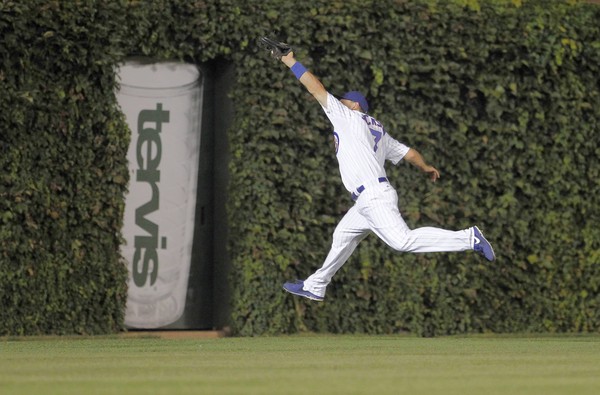
When I played rec league sports, my coaches would, almost without fail, send in the scrubs when the game was out of reach. The Cubs, commencing Operation Get It Over With—and facing a shutout sweep by the worst team in baseball—are taking the same approach today. Of the starting eight position players, only one is guaranteed to be a regular starter next year, and it's a preview of how tough 2013 will be for the team.
1. Tony Campana, LF: .260 BA, .296 SLG, 23.0 K%
2. Adrian Cardenas, 2B: .193 BA, .298 SLG, 17.1 K%. But an excellent pianist.
3. Starlin Castro, SS: Actually good, and his start today means he's played every game.
4. Brian LaHair, 1B: 33.1 K%
5. Dave Sappelt, LF: Who? No, he's actually been pretty good. Surprisingly good in 74 plate appearances: his OBP is 40 points higher than his AAA numbers, and his slugging percentage is 90 points higher. This is probably about right: "he’s athletic, quick and has enough of a hit tool to profile as a legitimate fourth outfielder. The problem? Chicago has about nine other guys who fit the same mold." (See Tony Campana.)
6. Josh Vitters, 3B: .113 BA, .196 SLG, 4.8 BB%, 31.4 K%, and -1.4 WAR in 35 games (meaning that, compared to your average "replacement" player, Vitters has theoretically cost the Cubs 1.4 wins in those 35 games. It's the sixth-worst in baseball for players with a minimum of 100 plate appearances, and Vitters has 105, aided by his mediocre defense.
7. Brett Jackson, CF: .179 BA, 41.3 K%. At least he's shown some pop (.350 SLG), and some patience (15.2 BB%).
8. Anthony Recker, C: Only 17 plate appearances, but only three hits and no walks. The Cubs acquired Recker for Blake Lalli in a trade of pretty good minor league catchers who are unlikely major-league regulars. No one's really sure why.
Most worrisome are Jackson and Vitters, two highly touted prospects who are trying to prove they're not Four-A All Stars. (Both have a little over 100 plate appearances, which is a small sample size, but not a non-existent one.) Jackson is widely expected to start next year; Vitters is expected to be a starter as well. They're 24 and 23 respectively, so both have some time to improve, but not that much time.
On the other hand, there are reasons for Cubs fans to expect a better season next year, even before whatever happens in the off-season.
* Welington Castillo has been good, and is obviously a vast improvement on the disappointing Geovany Soto.
* Next year will bring a full season of Anthony Rizzo, who has been excellent.
* Starlin Castro managed a full 162 games this season, and showed some of the improved power some are expecting of him as he gets older, with four more home runs in 30 fewer plate appearances as of yesterday; his ISO has gone from .108 to .125 to .148 in his first three years. And if you buy advanced fielding metrics, Castro has improved despite his high-profile lapses.
* The unpredictable Jeff Samardzija finished out a full season as the Cubs' best and most reliable starter, with peripheral stats as good as some of the game's best pitchers: 9.27 K/9, fifth highest and baseball, and a pretty good 2.89 BB/9. Compare that to Justin Verlander (9.03/2.27), Cole Hamels (9.03/2.17), and Gio Gonzalez (9.35/3.43). His ERA was a less than ideal 3.81, but it's still an impressive transition from the bullpen; prior to this season, he'd only started five games at the major-league level, and none last year. He finished the season under .500, but Samardzija also received the second-worst run support in baseball among all 90 qualified starters, at 3.21 runs per game. (Paul Maholm, who also had a good season, got the tenth-least.)
* The Cubs played more rookies this season than any team in baseball, including an epic seven rookie pitchers in one game against the best team in the National League. Next year… a lot of them won't be rookies, so that might help.
They'll go into 2013 with talent at crucial positions—a likely new staff ace, a good young catcher, one of the best young shortstops in baseball. What will be interesting this offseason is how they approach the holes, and whether they decide Jackson and Vitters are holes, or the future.
Photograph: Chicago Tribune


